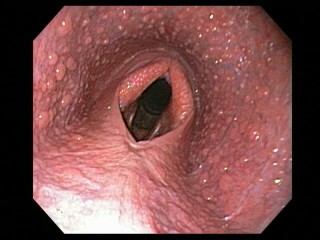This disease results in the soft palate ”displacing” from its normal position under the epiglottis such that it is now on top of it. This creates an obstruction when the horse breathes out because the soft palate acts like a parachute, which then creates a rise in carbon dioxide in the horse’s bloodstream and subsequent exercise intolerance.. The soft palate can be permanently or intermittently displaced, and t he cause for this disease is not completely understood. Consequently, dynamic endoscopy with the horse actively exercising is often necessary to diagnose cases of DDSP, and it is not uncommon to see other upper airway abnormalities in conjunction with this problem. Clinical signs seen with this disease include exercise intolerance and gurgling or “growling” noises when exercising.

Diagnostics
Video endoscopy, Dynamic endoscopy, Radiographs
Treatment options
There are several ways to treat a horse that has a dorsal displacement of the soft palate. One of the least invasive procedures is a sternothyrohyoideus myectomy, which carries a 65% success rate. With this procedure, a 4 inch portion of muscle is removed on the bottom of the neck just behind the jaw bone. The procedure is performed with the horse under standing sedation, and there are minimal cosmetic defects created with this procedure. The gold standard procedure at this time is known as a “tie forward,” which carries an 85% success rate. A tie forward procedure is performed with the horse under general anesthesia. An incision is made between the jaw bones, and a permanent suture is placed to pull the larynx up and forward to prevent the soft palate from displacing.



